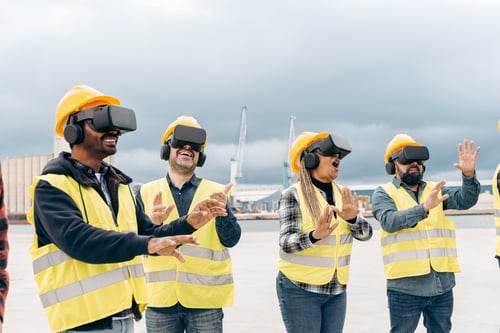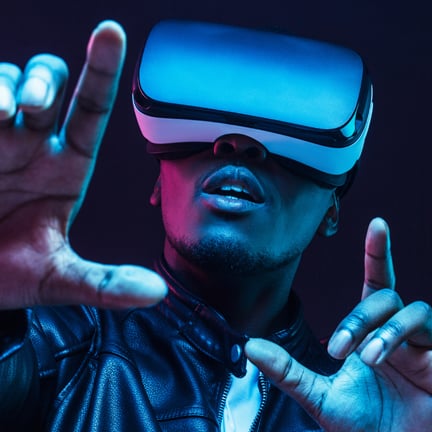
Everything you need to know about haptic technology
If you’ve been keeping up with the latest trends in technology, then you’ve probably heard of the term “haptics.” Though it’s a concept that few people are familiar with, haptic technology has started to infiltrate every aspect of the techno world and will only continue to be implemented in multiple fields, devices and products for years to come.
If you’ve landed on this page, then you’re probably asking yourself: what exactly is haptic technology? What does it mean when something gives you haptic feedback? And, finally, how exactly is haptic technology used today?
This page will take you through a step-by-step breakdown of the immersive world of haptics with information on everything from its history, how it works, its current uses, its potential uses for the future as well as give you a breakdown of how D-BOX uses haptics to make life resonate.
What are haptics?
Definition
According to the Oxford Dictionary & Lexico, haptics “relate to the sense of touch, in particular relating to the perception and manipulation of objects using the senses of touch and proprioception.” They further define haptics as “the use of technology that stimulates the sense of touch and motion, especially to reproduce in remote operation or computer simulation the sensations that would be felt by a user interacting directly with physical objects.”
The word itself originates from the Greek word haptesthai, meaning to touch.
What does this all mean?
This means that haptics, in simple terms, is the science of transmitting and understanding information through the sense of touch. The mechanism that stimulates the sense of touch and that is behind the transmission of information is referred to as haptic technology, while the information conveyed is called haptic feedback.
How the Sense of Touch Works & What This Means for Haptics
The skin is a complex organ that contains a massive number of nerve endings and touch receptors that come together to be known as the somatosensory system
It is the somatosensory system that informs the brain of all the sensations we feel. When something is too hot or too cold, when something is painful, or when something tickles, it is this system that relays the message to your brain.
It does this through your touch receptors. Your touch receptors convey a message to the nearest neuron, which then conveys the message to the next nearest neuron, and so on, until the message reaches the brain. The brain then tells the body how to react to the sensation—and all of this is done in a fraction of a second. This is why we pull our hands back immediately after accidentally touching a hot stove, for example.
Just as how graphics & audio target a person’s sense of sight and sound to convey information, haptics target a person’s somatosensory system to give context and to communicate specific information.
A common example of the somatosensory system communicating with most of the current adult population through haptics would be when you hold down an app on your iPhone and your finger feels a pull. This pull is the iPhone’s haptic motors (the haptic technology) communicating to your brain through touch
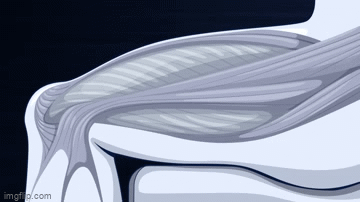
Purpose of Haptic Technology
While the main goal of haptic technology is to communicate something to the user, there are many different reasons why one would want to communicate in the first place. Haptic technology can be used to teach something, to train someone, to build something or simply to entertain the user.
Despite the many different ways and reasons that haptic technology can be used to communicate, there is one thing they all have in common: they allow inanimate objects to re-create the feeling of using real objects, and then in turn allow these inanimate objects to touch you back.
How exactly haptic technology is used depends on what you are trying to communicate but at its core, the purpose of haptics is to act as a form of touch communication between an inanimate object and a human.
How Haptic Technology Started
Though its origins are hard to trace, one of the earliest applications of haptic technology was in aviation. The controls of a plane would vibrate in tandem with turbulence so pilots could better understand what was going on outside of the plane! The haptic feedback would also alert the pilots if the aircraft was approaching a stall, increasing flight safety.
After this initial use of haptics, a patent for a tactile telephone was granted in 1973 as the use of haptics continued to expand. Today, haptic technology can be found in smartphones, laptops, vests, chairs, robots, simulators and more.

How Does Haptic Technology Work?
Now that you understand the basics of haptics and haptic technology, you might be wondering, “just how exactly does it work?”
In short, haptic technology creates haptic feedback through the application of force, vibration and motion. These sensations are what target the user’s sense of touch when interacting with something that contains haptic technology.
There are a few different ways to mechanically create these forces, vibrations and movement.
The first (and most common) is by using an eccentric rotating mass (also known as an ERM) actuator. As the ERM rapidly spins, the force from the weight becomes unstable, causing the motor to move. The moved motor is what creates the haptic feedback!
ERM’s were followed by linear resonant actuators (LRA’S), which consist of a magnet attached to a spring, surrounded by coil and protected by an outer layer. The electromagnetic coil is energized so that the magnetic mass moves back and forth within it, creating the sensation of the feedback. The Nintendo Switch uses a LRA actuator, for example, to give gamers a more immersive experience.
Most types of haptic technology use either ERM’s or LRA’s to provide haptic feedback, but new types of technology are still emerging and evolving to be more accessible and more realistic. The key to remember, however, is that in general haptic feedback is caused by a device that applies a force, pressure or resistance by using actuators to create the desired sensations.
Haptics vs Vibrations
The next thing you might be wondering is “what exactly is the difference between haptic feedback and vibrations?”
While both haptic feedback and vibration are very similar, the difference lies in the complexity of the vibration pattern and the intention.
The fact that the main goal of haptic feedback is to communicate separates it from vibration, which usually comes on one waveform and in a similar, continuous intensity throughout its duration. Haptics, on the other hand, use a variety of advanced waveforms to convey information to the user.
Essentially, if a sensation doesn’t convey specific information, it’s simply a vibration. The distinction is made when the vibration alerts you to something—if you’re playing a videogame and a vibration on the left side of your controller alerts you to a bomb going off to your left, then the vibration is communicating—making it a form of haptic feedback.
Haptics vs Tactile
Similarly to vibrations, haptics and tactile go hand-in-hand. Tactile is simply anything that’s related to the sense of touch, so it is impossible to have haptic feedback without some form of tactile feedback first occurring!
In essence, haptic feedback occurs when tactile feedback (for example, the texture of a dumbbell against your fingertips) combines with kinesthetic feedback (sensations from our own muscular effort, for example the feeling of your muscles contracting while lifting the dumbbell) to create communicative haptic feedback. While it is still possible to have haptic feedback without both elements, haptics are at their most efficient when both are present.
Tactile feedback can be considered a light form of haptics, but on its own, it does not provide much force since it’s limited to being skin level only.

How is haptic technology used today?
Like most technological evolutions, haptic feedback has evolved so deeply and so quickly that it has been integrated into our everyday lives without most people even knowing what the word “haptic” means.
The most common examples of haptic technology that the average person deals with on a daily basis include the haptics on Apple’s iPhone and on other smartphones, haptic feedback given to you by your car’s steering wheel (when you veer out of your lane, for example) as well as your car’s touch screen (that gives your finger a little ‘click’ when you press a button). The next most common example would be haptic feedback in gaming consoles, which is what creates the renowned rumble in controllers that you feel in different game scenarios.
However, haptic technology is not just limited to smaller applications like those ones. Since there is no limit as to what haptics can be integrated into, the growth of haptic technology will only continue to expand into new fields for years to come.
While these new haptic innovations are being worked on every day, haptics are currently seen in some fields more than others.
Most Common Haptic Applications
As mentioned above, many people are familiar with haptic feedback because of videogames, which have almost all had some form of haptic technology since the early 2000’s. As a matter of fact, the first use of haptics in videogames dates back to the 1970’s! Sega’s game Moto-Cross is credited with the title of the first haptic game, as it allowed players to feel rumble when their motorcycles crashed.
Haptic feedback became so popular in the industry from that point on that the market demanded it and made it a “must-have” in any new gaming console, which is why it remains as widespread as it is today.
Adding realistic haptic feedback to a console or to a game makes a company stand out from the rest, which is why developers are still trying to push the limits of what they can do with videogame haptics.
Today, controllers like the Steam Controller and the PlayStation DualSense controller are changing the way games are played with ultra realistic haptic feedback allowing you to feel a spell building in a wand or feel that your character is running on grass or concrete, for example, as opposed to just feeling the traditional rumble. These haptics serve to further immerse players in the game and to create a whole new gaming experience!
Haptics in gaming are also evolving in new ways, with accessories such as haptic gaming headsets slowly making their way onto the market.
On the bigger side of the spectrum, haptic technology is often integrated into teleoperators and robotics.
Haptic technology is incredibly useful for teleoperators because it allows remote controlled robotic tools to give operators critical feedback on the forces that the robots are facing in real-time, allowing the operators to perform their tasks with extreme precision and accuracy.
Haptic feedback being used in teleoperations goes as far back as the 1950’s, when robotic arms were developed to handle and manipulate toxic substances from afar.
Because of the precision of this type of technology, robotics is arguably one of the most important uses of haptic feedback as it can be used make fields such as medicine and aviation more efficient.
In the medical and dental fields, haptic feedback has enabled the development of surgery via telepresence—allowing the best surgeons from around the globe to operate on their patients from a distance. The haptic robotic technology will communicate tactile and resistance feedback identical to what they doctors would be feeling if they were really working on the patient, opening the doors for lifesaving procedures performed abroad.
Haptic feedback is also being used in medicine and dentistry for training purposes and help student doctors prepare for minimally invasive procedures such as laparoscopies, endoscopies and more.
Haptic technology is not only making waves on Earth—but its evolution is allowing humans to use haptic feedback in space. Whether the technology is on Earth with the astronauts in orbit or vice versa, haptic technology will allow us to gain a better understanding of the forces being exerted in outer space through haptic robots or exoskeletons.
Technology like this would allow NASA and the European Space Agency, among others, who have collaborated on METERON (multi-purpose end-to-end robotic operation network) to eventually allow robots to build infrastructure on foreign planets with humans controlling them from Earth.
Though it’s an ambitious goal, the space agencies already possess extremely complex haptic technology that will help them in space exploration and help them build infrastructure on other planets.
As far as aviation goes, haptic feedback allows pilots to be instantly aware of any issues and reduces the risk of pilots entering dangerous flight conditions through the steering equipment. If all is well with the flight and there’s no imminent danger, haptic feedback in aviation works to increase a pilot’s overall situational awareness of the plane they’re flying.
Professional simulators are gaining a lot of traction when they have haptic feedback incorporated in them as it allows individuals to feel realistic sensations that they would otherwise only experience if they were to actually live that specific situation.
One of the most common haptic simulators are flight simulators, in which pilots can train in rain, shine, with a healthy engine or with a damaged one, in order to best prepare for every possible situation that could occur while flying the skies.
After enough time in the simulators, the haptic feedback will have created muscle memory for certain situations in the trainees, which springs back into action when the “real deal” situation arrives.
Haptic feedback is not only useful for scientific and technological purposes, but also for entertainment! Sectors such as virtual reality and theme parks have seen a recent demand for haptic feedback in their attractions, as people continue to seek new ways to be entertained in their day-to-day lives.
The goal of haptic feedback in entertainment is to heighten the user’s sense of presence and to make the experiences as realistic as possible, which is usually done by making them truly feel what they are seeing and hearing, turning their audiovisual experience into an out-of-body one.
Haptic technology like this also exists for consumers to purchase to entertain themselves at home—the Woojer Vest, for example, can be purchased online and delivers low frequencies throughout the body to enhance multiple types of at-home entertainment.
Haptic Technology & Science
While almost anyone who tries a piece of haptic technology and who experiences haptic feedback will tell you that the experience was unlike anything they’ve ever experienced before, the benefit of haptic technology is not purely subjective.
It may seem obvious to users that the haptic feedback they experience heightens their sense of enjoyment and accuracy, but there are many scientific studies that also back this belief. These studies have highlighted the effects of haptic feedback on the human body and have evaluated its efficiency in multiple situations.
A study published by the Journal of Neuroscience sought to investigate the effect of haptic technology on product placement and memorization. The results of the experiment showed that high-fidelity vibro-kinetic experiences produce a higher amplitude in the P3 component of the brain than of those who did not have the haptic experience, which suggests that haptic technology has an implicit effect on a user’s memorization.
Another study in the Journal of Neural Engineering looked at the underlying mechanisms that increase viewer enjoyment when haptic feedback is used in conjunction with audiovisual entertainment experiences. This study found that the parts of the brain that are used primarily for emotion were activated when the person was receiving haptic feedback, explaining why haptic technology has the ability to trigger emotion and therefore a greater overall sense of enjoyment.
The Interuniversity Research Centre on Enterprise Networks, Logistics and Transportation did a study that sought to validate the efficiency of training in a driving simulator when it comes to training transfer for on-road driving.
To do so, they had some driving students train in a simulator while others purely followed a normal training protocol.
The study found that the most critical of driving safety skills were successfully transferred to students who used the simulator, and in a greater sense than those who exclusively practiced on the road.
The pass rates of the driving exam itself were also higher for the group who trained in the simulator, and the simulator group of students were found to have less driving infractions two years after obtaining their license. This implies that the haptic feedback in the simulator made them safer drivers.
How D-BOX Uses Haptic Feedback
Movie Theaters
D-BOX is renowned for the premium haptic theatrical experience that they offer moviegoers around the world.
This experience is brought to cinephiles through actuators that allow them to experience vibrations, motion and textures through their cinema seat. However, it is not an automation—D-BOX employs haptic designers whose sole job it is to watch the movies, encode the content with haptic tracks that will make the movement perfectly in sync with the action on the big screen, and then fine-tune the experience to truly augment the level of immersion that moviegoers feel in a D-BOX seat.

Sim Racing
As the exclusive official supplier of haptic systems of the FIA, D-BOX actuators provide an extremely realistic racing experience for everyone from amateurs of the sport to professional drivers who are looking to fine-tune their training regimens.For nearly 25 years, D-BOX has been perfecting the art of haptics—designing over 65,000 unique effects built from a mix of motion, vibrations, and textures. These effects can be combined in endless ways to create a realistic, responsive experience that brings your setup to life.
In sim racing, that means feeling what the car feels. You’ll sense when your tires lose grip, when the road surface changes, or when your car starts to understeer into a turn. The motion system doesn’t just shake for the sake of it—it sends you the kind of real-time feedback that helps you adjust on the fly and improve your performance.
One of the things D-BOX is known for is how precise the feedback is. Sure, you’ll feel it when you hit a wall—but most of the time, the sensations are incredibly subtle. So subtle that you can often tell which car you’re driving just by the feel of the engine vibrations.
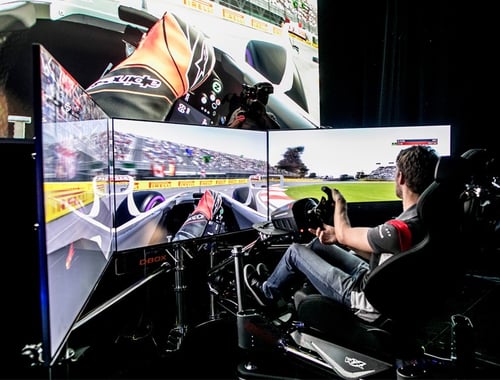
Attractions & Virtual Reality
D-BOX helps their partners build interactive rides, exhibits and special events that make the overall experience of the attraction more memorable for all through their patented haptic technology.
If a client is building a virtual roller coaster, D-BOX integrates their actuators into the attraction’s platform in order to accurately re-create the tactile and kinesthetic sensations that make the user feel as though they were at an actual amusement park, riding their favourite coaster.
D-BOX’s haptic feedback technology can also be customized and integrated into virtual reality applications to make users truly forget that they’re not in the world being shown to them, with the motion being perfectly synchronized to the happenings of the virtual world.
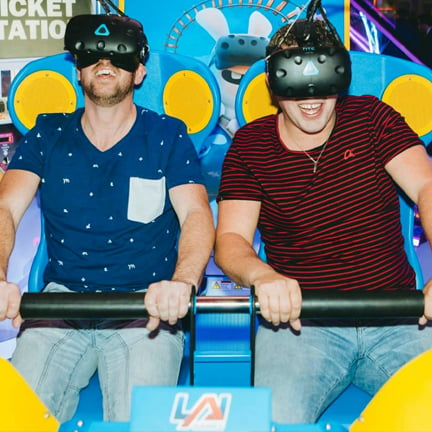
Professional Training and Simulation
As the study by the Interuniversity Research Centre shows, haptic technology is an efficient tool for training transfer.
D-BOX works with their partners to analyze their training goals and then to integrate their haptics into simulators in ways that will help companies reach their training goals and make training safer for all involved.
The haptic feedback communicated through D-BOX’s actuators stimulates muscle memory and is scientifically proven to prevent motion sickness, leading to an optimized training curriculum and overall safer practices.
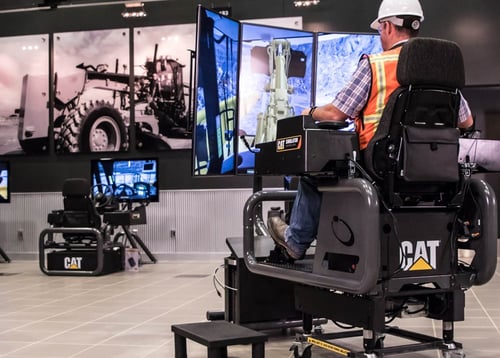
The Future of Haptics
Though most people are currently unaware of what haptic technology is, it has permeated everyday life for the majority of society and is only going to continue to rapidly expand. With applications in medicine, aviation, entertainment and more, there is no limiting what haptic technology will allow us to do going forward!
If you want to learn more about haptic technology and think it can enhance your entertainment or professional simulation experiences, feel free to communicate with us.
